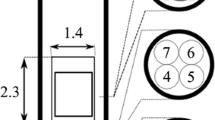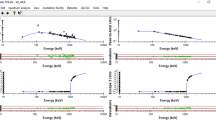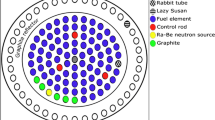Abstract
Neutron flux parameters at pneumatic irradiation tube Pn-1 of Kyoto University Research Reactor (KUR) were measured in order to establish k0-INAA method. The measured thermal to epithermal neutron fluxes ratio (f), shape factor of epithermal neutron flux (α), and thermal (ϕth) and fast (ϕf) neutron fluxes were 29.7 ± 2.0, − 0.015 ± 0.003, and (3.17 ± 0.11) × 1012 and (4.79 ± 0.16) × 1011 cm−2 s−1 at 1 MW, respectively. The neutron flux spectrum showed a remarkable stability over the weekly operation cycle as well as at different reactor powers. The analysis results of reference materials [multi-element liquid standard, and Oriental Basma Tobacco Leaves (INCT-OBTL-5)] revealed that the k0-INAA procedure established at the KUR can be regarded as a reliable standardization method of multi-elemental INAA; measured concentrations have zeta-score < ± 2. Corrections due to nuclear interference resulting from fast neutron reactions must be considered for samples with relatively high concentrations of interfering elements. MCNP5 code was used to estimate the total efficiencies of gamma-rays, which might be required to calculate correction factor for the true coincidence effects.





Similar content being viewed by others
References
Sekimoto S, Homura Y, Ho VD, Inagaki M, Shirai N, Ohtsuki T (2019) Neutron activation analysis of carbonate reference materials: coral(JCp-1) and giant clam (JCt-1). J Radioanal Nucl Chem 322:1579–1583
Shirai N, Hidaka Y, Yamaguchi A, Sekimoto S, Ebihara M, Kojima H (2015) Neutron activation analysis of iron meteorites. J Radioanal Nucl Chem 303:1375–1380
Shirai N, Toktaganov M, Takahashi H, Yokozuka Y, Sekimoto S, Ebihara M (2015) Multielemental analysis of Korean geological reference samples by INAA, ICP-AES and ICP-MS. J Radioanal Nucl Chem 303:1367–1374
Sekimoto S, Kobayashi T, Takamiya K, Ebihara M, Shibata S (2008) Chemical composition of magnetic spherules collected from deep sea sediment. J Radioanal Nucl Chem 278:319–322
https://www-s.nist.gov/srmors/view_detail.cfm?srm=2783, accessed on 11 May 2020.
Yatkin S, Trzepla K, White WH, Hyslop NP (2018) Generation of multi-element reference materials on PTFE filters mimicking ambient aerosol characteristics. Atmos Environ 189:41–49
Benson RA, Mohamed NMA, Soliman M, Hassan M, Abou Mandour MA (2017) Application of k0-INAA for evaluating the essential and toxic elements of some medicinal plants in West Pokot County, Kenya. J Radioanal Nucl Chem 314:23–29
Soliman MA, Abdou FS, Mohamed NM (2020) Novel neutron activation analysis scheme for determination of trace elements in medicinal plants infusion. J Radioanal Nucl Chem 325:841–846
Attallah MF, Metwally SS, Moussa SI, Soliman MA (2019) Environmental impact assessment of phosphate fertilizers and phosphogypsum waste: elemental and radiological effects. Microchem J 146:789–797
Mejjad N, Laissaoui A, El-Hammoumi O et al (2016) Sediment geochronology and geochemical behavior of major and rare earth elements in the Oualidia Lagoon in the western Morocco. J Radioanal Nucl Chem 309:1133–1143
Pino F, Sajo-Castelli AM, Barros H et al (2013) k0-INAA of Venezuelan ceramics and complete statistical analysis to establish their provenance. J Radioanal Nucl Chem 298:1257–1272
Blaauw M. The k0-IAEA program manual for version 5.00. International Atomic Energy Agency, Vienna, Austria. http://www-naweb.iaea.org/napc/iachem/files/k0IAEAhelp.pdf, accessed on 20 May 2020.
Soliman M, Mohamed NMA, Gahen M, Saad EA, Yousef SK, Sohsah MA (2011) Implementation of k0-standardization method of the INAA at ETRR-2 research reactor. J Radioanal Nucl Chem 287:629–634
Soliman MA, Mohamed NMA, Takamiya K, Sekimoto S, Inagaki M, Oki Y, Ohtsuki T (2020) Estimation of 47Sc and 177Lu production rates from their natural targets in Kyoto University Research Reactor. J Radioanal Nucl Chem 324:1099–1107
De Corte F, Simonits A (2003) Recommended nuclear data for use in the k0- standardization of neutron activation analysis. Atomic Data Nucl Data Tables 85:47–67
Erdtmann G (1976) Neutron Activation Tables, Germany
The k0-International Scientific Committee. http://www.kayzero.com/k0naa/k0naaorg/Nuclear_Data_SC/Entries/2019/4/15_Update_of_k0-database_Ba-131.html. Accessed on 3 May 2020.
Kučera J, Kubešová M, Lebeda O (2018) Improvement of the Ca determination accuracy with k0-INAA using an HPGe coaxial detector with extended energy range efficiency calibration. J Radioanal Nucl Chem 315:671–675
Mohamed NMA (2017) Accurate corrections of HPGe detector efficiency for NAA samples. J Radiat Nuclear Appl 2:37–43
Gilmore G (2008) Practical gamma-ray spectrometry. Chapters 7–16. Wiley, Chichester
De Corte F (1987) The k0-standardization method; A move to the optimization of neutron activation analysis. Faculteit van de Wetenschappen, Instituutvoor Nucleaire Wetenschappen.
Alnour I, Wagiran H, Ibrahim N, Hamzah S, Siong W, Elias M (2016) New approach to calculate the true coincidence effect of HpGe detector. AIP Conf Proc 1704:030005. https://doi.org/10.1063/1.4940074
Kafala S (1994) Simple method for true coincidence summing correction. J Radioanal Nucl Chem 191:105–114
Soliman MA, Mohamed NMA, Osman AM, Abdel-Monem AM (2014) Performance of flowing sample neutron activation analysis technique for determination of multi-elemental content. J Radioanal Nucl Chem 299:89–93
Analytical Methods Committee Technical Briefs (2016) z-Scores and other scores in chemical proficiency testing—their meanings, and some common misconceptions. Anal Methods 8: 5553–5555.
Manh-Dung H, Quang-Thien T, Van-Doanh H, Dong-Vu C, Thi-Sy N (2016) Quality evaluation of the k0-standardized neutron activation analysis at the Dalat research reactor. J Radioanal Nucl Chem 309:135–143
De Corte F, Simonits A et al (1993) Recent advances in the ko-standardizationof neutron activation analysis: extensions, applications, prospects. J Radioanal Nucl Chem 169:125–158
Acknowledgements
This work is financially supported by Japan Society for the Promotion of Science (JSPS); the first author (M. Soliman) is JSPS Postdoctoral Fellow (ID P17384).
Author information
Authors and Affiliations
Corresponding author
Additional information
Publisher's Note
Springer Nature remains neutral with regard to jurisdictional claims in published maps and institutional affiliations.
Supplementary Information
Below is the link to the electronic supplementary material.
Rights and permissions
About this article
Cite this article
Soliman, M., Abdou, F.S., Ho, VD. et al. Measurement of neutron flux parameters for implementation of k0-INAA at Kyoto University Research Reactor. J Radioanal Nucl Chem 331, 3949–3956 (2022). https://doi.org/10.1007/s10967-022-08391-1
Received:
Accepted:
Published:
Issue Date:
DOI: https://doi.org/10.1007/s10967-022-08391-1




